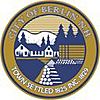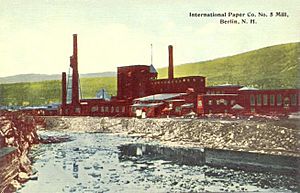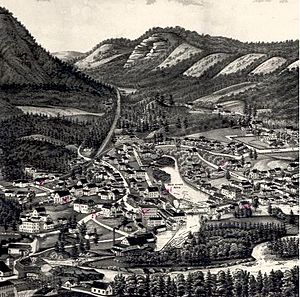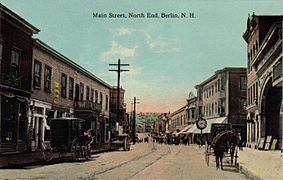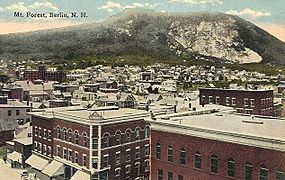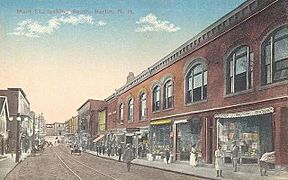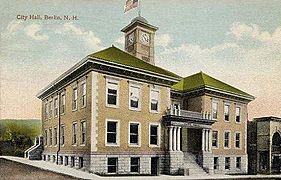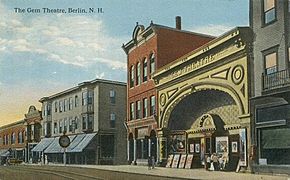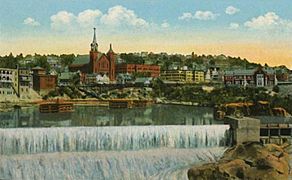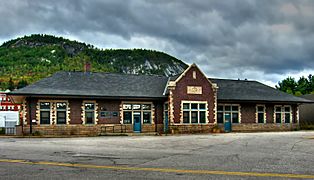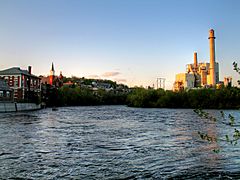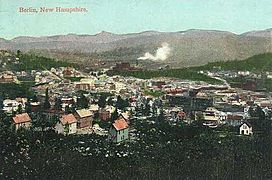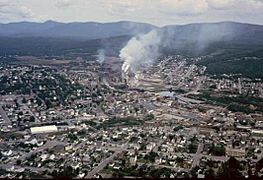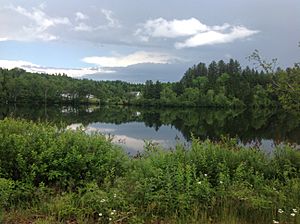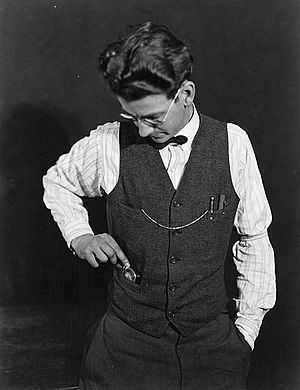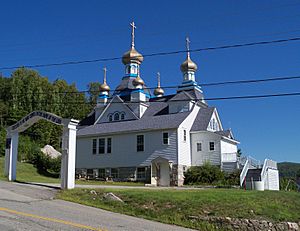Berlin, New Hampshire facts for kids
Quick facts for kids
Berlin, New Hampshire
|
||
|---|---|---|
|
City
|
||
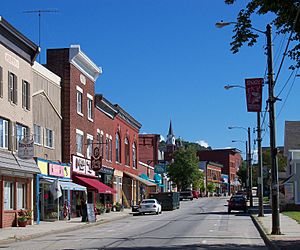
Downtown Berlin
|
||
|
||
| Nicknames:
The City That Trees Built Paper City Tansy Town Hockey Town USA |
||
| Motto(s):
Your Adventure Starts Here
|
||
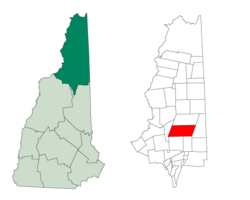
Location in New Hampshire
|
||
| Country | United States | |
| State | New Hampshire | |
| County | Coös | |
| Town | 1829 | |
| City | 1897 | |
| Area | ||
| • Total | 62.20 sq mi (161.10 km2) | |
| • Land | 61.35 sq mi (158.89 km2) | |
| • Water | 0.85 sq mi (2.21 km2) | |
| Elevation | 1,020 ft (310 m) | |
| Population
(2020)
|
||
| • Total | 9,425 | |
| • Density | 153.63/sq mi (59.32/km2) | |
| Time zone | UTC−5 (EST) | |
| • Summer (DST) | UTC−4 (EDT) | |
| ZIP Code |
03570
|
|
| Area code(s) | 603 | |
| FIPS code | 33-05140 | |
| GNIS feature ID | 0871491 | |
Berlin (/ˈbɜːrlɪn/ BUR-lin) is a city along the Androscoggin River in Coös County in northern New Hampshire, United States. It is the northernmost city in New Hampshire and the only city in Coös County. The population was 9,425 at the 2020 census, down from 10,051 at the 2010 census.
It includes the village of Cascade in the south part of the city. Located in New Hampshire's Great North Woods Region or "North Country", Berlin sits at the edge of the White Mountains, and the city's boundaries extend into the White Mountain National Forest. Berlin is home to the Berlin and Coos County Historical Society's Moffett House Museum & Genealogy Center, Service Credit Union Heritage Park, the Berlin Fish Hatchery, and the White Mountains Community College, member of the Community College System of New Hampshire.
Berlin is the principal city of the Berlin Micropolitan Statistical Area, which includes all of Coös County, New Hampshire, and Essex County, Vermont. Because Quebec is less than 60 miles (100 km) away, Berlin has many people of French Canadian descent in its population. Around 65% of its residents speak a variant of New England French, which is known locally as "Berlin French".
The pronunciation of Berlin was changed to BUR-lin, instead of Ber-LIN (as in Berlin, Germany), during World War I as a patriotic stand against Germany.
Contents
History
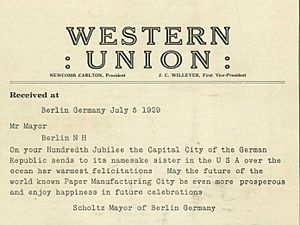
Around 11,000 years ago, small groups of Native Americans camped around the area of what is now called Berlin. In later years, the Eastern Abenaki tribes came to Berlin to mine rhyolite in Mt. Jasper.
When English colonists came to America, Berlin was first granted on December 31, 1771, by Colonial Governor John Wentworth, as "Maynesborough" after Sir William Mayne. But the grantees did not take up their claims, which disappeared with the Revolution. In 1802, Seth Eames and Gideon Tirrell were sent by the descendants of Mayne to explore and mark lots for settlers, and still no one came. Maynesborough was settled in 1823–1824 by William Sessions and his nephew, Cyrus Wheeler. Both men were from Gilead, Maine. Farming was the first industry. With 65 inhabitants in 1829, the New England town was reincorporated on July 1 as Berlin with the help of Cyrus' father, Thomas Wheeler.
Situated in a heavily forested region, the community developed early into a center for logging and wood industries. Falls on the Androscoggin River provided water power for sawmills. In 1826, a road was built to Gorham by Thomas, Amos, and Daniel Green. In 1851, the St. Lawrence & Atlantic Railroad entered Berlin, connecting it to other markets. Acquiring water, timber, and rail rights in the early 1850s, the H. Winslow & Company built a large sawmill at the head of "Berlin Falls". In 1868, William Wentworth Brown and Lewis T. Brown bought a controlling interest in the business and changed its name to the Berlin Mills Company.
By 1885, the mill town was home to several pulp and paper mills, including the Riverside Mill, Forest Fibre Company and White Mountain Pulp & Paper Company. Because of the need for labor in the mills, immigrants arrived from Russia, Norway, Finland, Italy, Sweden, Ireland, and Germany. Many others were French Canadians from nearby Quebec.
In 1872, a group of Scandinavians founded the nation's oldest ski club, which still exists today. It was originally called the North American Ski Club (in Norwegian, Nordamerikansk Skiklubben), but later was renamed the Nansen Ski Club. This was in honor of Fridtjof Nansen, who in 1888 skied across Greenland. In 1897, Berlin was incorporated as a city, the northernmost in the state.
As of 1874, the Boston and Maine Railway passed through the eastern portion of the town and operated on this line until the 1980s. The old railroad bed has since been converted for usage as an ATV trail.
Berlin's main industry in the early 20th century was the pulp and paper industries, which have been in a long decline since that time. As jobs left the area, the population has decreased and is about half its peak of more than 20,000 in the 1930 census. In 1917, the Berlin Mills Company was renamed the Brown Company, because of World War I and anti-German feeling against the enemy of the time. A short time after the Great Depression, the Brown Company went into receivership. Surviving with governmental help, it was bought and sold several times after World War II.
In 2001, American Tissue filed for bankruptcy, before which it had stopped paying city taxes. Its facilities were purchased in 2002 by Fraser Papers of Canada. But in March 2006, Fraser Papers announced the closing of Berlin's pulp mill. On May 6, 2006, 250 employees were displaced, some moving to Cascade's paper finishing mill, but most were left unemployed.
On October 3, 2006, the North American Dismantling Corporation of Michigan announced that it had bought the 121-acre (49 ha) defunct pulp mill site of Fraser Paper, and would spend a year demolishing the property to allow redevelopment. Laidlaw Energy LLC has since purchased a portion of the former Fraser property, including a large recovery boiler which it intends to convert into a 66-megawatt biomass plant in 2010–2011.
In the 1990s, the local historian and author Paul "Poof" Tardiff began writing articles in The Berlin Daily Sun. He later collected these in a three-volume series titled Once Upon a Berlin Time, which documents local history. He continued to write articles for the newspaper every Tuesday and Thursday until his death in 2018.
Recent economic development has been based on the correctional industry. The 750-bed Northern New Hampshire Correctional Facility was built in 1999 and employs approximately 200 people. In 2012, the Federal Bureau of Prisons opened a federal, 1200-bed medium security facility, which employs approximately 350 people.
-
Mount Forest c. 1912
-
A group of Russian immigrants at the Holy Resurrection Orthodox Church in 1915
Geography
Berlin is located at 44°28′07″N 71°11′02″W / 44.46861°N 71.18389°W (44.4686, −71.1839), in northern New Hampshire, north of the White Mountains, in the state's North Country region. The city is bordered to the south by Randolph and Gorham, north by Milan, east by Success and west by Kilkenny. New Hampshire Route 16 passes through the center of the city, leading north to Errol and eventually to Rangeley, Maine, and leading south through Gorham and Pinkham Notch to North Conway and the Seacoast Region of New Hampshire. New Hampshire Route 110 leads northwest out of Berlin through West Milan to Groveton. NH 110 is known locally as the Berlin-Groveton Highway.
According to the United States Census Bureau, the city has a total area of 62.2 square miles (161.1 km2), of which 61.4 square miles (158.9 km2) are land and 0.8 square miles (2.2 km2) are water, comprising 1.37% of the city. Berlin is situated at the confluence of the Androscoggin and Dead rivers. The Mahoosuc Range is to the southeast. Jericho Mountain State Park, created from a city park and from private land in 2005, is west of the city center and features a reservoir created in the 1970s and a network of ATV trails. The city's highest point is Mount Weeks, at 3,901 feet (1,189 m) above sea level. A prominent feature in the landscape of Berlin is 2,031-foot (619 m) Mount Forist, rising over the west side of the city. Approximately half of Berlin lies within the Connecticut River watershed, and half lies in the Androscoggin River watershed.
Rivers
Adjacent municipalities
Climate
Like all of northern New England, except the highest mountains, Berlin has a warm-summer humid continental climate (Köppen Dfb) characterized by cold, snowy winters and warm summers. Warm southerly or easterly airflows from an anticyclone in the Atlantic occasionally moderate the winters: on December 7, 2001, Berlin reached as warm as 68 °F or 20 °C. Blocks to the west, however, may drive very cold air from eastern Canada and the shallow, frozen Hudson Bay, providing extremely cold winters as occurred in 1917/1918, 1922/1923 and 1933/1934; the coldest temperature recorded in Berlin is −44 °F (−42.2 °C) on December 30 and 31, 1917. It can be expected that each year on average 68 afternoons will not top freezing, that 34.4 mornings will fall to or below 0 °F or −17.8 °C, and that 180.5 mornings will fall to or below freezing point. The average window for days not topping freezing is November 14 to March 29, and for subzero lows from December 11 to March 12. Snowfall is typically heavy at 79.7 inches or 2.02 metres, with the historical range being from 127 inches (3.23 m) between July 1995 and June 1996 to 34.2 inches (0.87 m) between July 1979 and June 1980.
Summer weather is generally moderate, though rain depressions moving from the tropics or strong frontal storms often produce heavy rainfall: the record daily rainfall is 6.50 inches (165.1 mm) on September 17, 1999, beating the previous record of 5.15 inches (130.8 mm) on the same day in 1932. The wettest month has however been September 1954 with 12.21 inches (310.1 mm) and the driest January 1981 with 0.14 inches (3.6 mm) actually consisting of 3.1 inches (0.08 m) of snow. Calendar year precipitation has ranged from a low of 29.47 inches (748.5 mm) in 2001 to 58.00 inches (1,473.2 mm) in 1954. Occasionally an offshore flow from the interior United States will produce very hot weather during the summer: the record high is 98 °F (36.7 °C) on four occasions: three consecutive days from June 3 to 5 in 1919 and on July 5, 1983.
| Climate data for Berlin, New Hampshire (1991–2020 normals; extremes 1886 to 1892 and since October 1917) | |||||||||||||
|---|---|---|---|---|---|---|---|---|---|---|---|---|---|
| Month | Jan | Feb | Mar | Apr | May | Jun | Jul | Aug | Sep | Oct | Nov | Dec | Year |
| Record high °F (°C) | 67 (19) |
69 (21) |
80 (27) |
89 (32) |
94 (34) |
98 (37) |
98 (37) |
97 (36) |
95 (35) |
88 (31) |
77 (25) |
68 (20) |
98 (37) |
| Mean maximum °F (°C) | 51.0 (10.6) |
50.8 (10.4) |
58.8 (14.9) |
76.7 (24.8) |
84.6 (29.2) |
88.6 (31.4) |
88.8 (31.6) |
87.0 (30.6) |
84.1 (28.9) |
75.3 (24.1) |
65.4 (18.6) |
53.1 (11.7) |
90.8 (32.7) |
| Mean daily maximum °F (°C) | 26.9 (−2.8) |
29.7 (−1.3) |
38.4 (3.6) |
51.9 (11.1) |
65.5 (18.6) |
73.7 (23.2) |
78.2 (25.7) |
76.8 (24.9) |
69.5 (20.8) |
56.6 (13.7) |
44.0 (6.7) |
32.4 (0.2) |
53.6 (12.0) |
| Daily mean °F (°C) | 16.1 (−8.8) |
18.0 (−7.8) |
27.2 (−2.7) |
40.6 (4.8) |
53.0 (11.7) |
61.9 (16.6) |
66.5 (19.2) |
64.7 (18.2) |
57.4 (14.1) |
45.9 (7.7) |
34.9 (1.6) |
23.3 (−4.8) |
42.5 (5.8) |
| Mean daily minimum °F (°C) | 5.4 (−14.8) |
6.3 (−14.3) |
16.0 (−8.9) |
29.4 (−1.4) |
40.6 (4.8) |
50.1 (10.1) |
54.9 (12.7) |
52.5 (11.4) |
45.2 (7.3) |
35.1 (1.7) |
25.7 (−3.5) |
14.1 (−9.9) |
31.3 (−0.4) |
| Mean minimum °F (°C) | −15.5 (−26.4) |
−11.8 (−24.3) |
−5.5 (−20.8) |
17.9 (−7.8) |
29.4 (−1.4) |
37.9 (3.3) |
45.9 (7.7) |
42.0 (5.6) |
32.1 (0.1) |
24.1 (−4.4) |
10.5 (−11.9) |
−5.7 (−20.9) |
−17.7 (−27.6) |
| Record low °F (°C) | −35 (−37) |
−39 (−39) |
−29 (−34) |
−9 (−23) |
18 (−8) |
29 (−2) |
33 (1) |
31 (−1) |
20 (−7) |
8 (−13) |
−13 (−25) |
−44 (−42) |
−44 (−42) |
| Average precipitation inches (mm) | 2.73 (69) |
2.44 (62) |
3.00 (76) |
3.43 (87) |
3.55 (90) |
4.23 (107) |
4.08 (104) |
3.75 (95) |
3.35 (85) |
4.92 (125) |
3.39 (86) |
3.73 (95) |
42.60 (1,082) |
| Average snowfall inches (cm) | 18.2 (46) |
21.0 (53) |
16.1 (41) |
4.2 (11) |
0.2 (0.51) |
0.0 (0.0) |
0.0 (0.0) |
0.0 (0.0) |
0.0 (0.0) |
0.5 (1.3) |
4.6 (12) |
17.2 (44) |
82.0 (208) |
| Average extreme snow depth inches (cm) | 16.1 (41) |
21.7 (55) |
19.7 (50) |
5.8 (15) |
0.2 (0.51) |
0.0 (0.0) |
0.0 (0.0) |
0.0 (0.0) |
0.0 (0.0) |
0.5 (1.3) |
3.2 (8.1) |
12.9 (33) |
26.4 (67) |
| Average precipitation days (≥ 0.01 in) | 10.2 | 9.1 | 10.0 | 10.5 | 12.1 | 12.3 | 11.8 | 10.3 | 9.3 | 11.7 | 10.2 | 12.2 | 129.7 |
| Average snowy days (≥ 0.1 in) | 7.6 | 6.6 | 5.3 | 1.9 | 0.1 | 0.0 | 0.0 | 0.0 | 0.0 | 0.4 | 2.6 | 7.3 | 31.8 |
| Source: NOAA | |||||||||||||
Demographics
| Historical population | |||
|---|---|---|---|
| Census | Pop. | %± | |
| 1830 | 73 | — | |
| 1840 | 116 | 58.9% | |
| 1850 | 173 | 49.1% | |
| 1860 | 433 | 150.3% | |
| 1870 | 529 | 22.2% | |
| 1880 | 1,144 | 116.3% | |
| 1890 | 3,729 | 226.0% | |
| 1900 | 8,886 | 138.3% | |
| 1910 | 11,780 | 32.6% | |
| 1920 | 16,104 | 36.7% | |
| 1930 | 20,018 | 24.3% | |
| 1940 | 19,084 | −4.7% | |
| 1950 | 16,615 | −12.9% | |
| 1960 | 17,821 | 7.3% | |
| 1970 | 15,256 | −14.4% | |
| 1980 | 13,084 | −14.2% | |
| 1990 | 11,824 | −9.6% | |
| 2000 | 10,331 | −12.6% | |
| 2010 | 10,051 | −2.7% | |
| 2020 | 9,425 | −6.2% | |
| U.S. Decennial Census | |||
As of the census of 2010, there were 10,051 people, 4,178 households, and 2,515 families residing in the town. There were 4,910 housing units, of which 732, or 14.9%, were vacant. The racial makeup of the town was 96.5% white, 0.8% African American, 0.4% Native American, 0.3% Asian, 0.0% Native Hawaiian or Pacific Islander, 0.2% some other race, and 1.8% from two or more races. 1.5% of the population were Hispanic or Latino of any race.
Of the 4,178 households, 25.8% had children under the age of 18 living with them, 43.2% were headed by married couples living together, 11.8% had a female householder with no husband present, and 39.8% were non-families. 33.3% of all households were made up of individuals, and 15.2% were someone living alone who was 65 years of age or older. The average household size was 2.18, and the average family size was 2.71. 955 city residents lived in group quarters rather than households.
In the city, 18.4% of the population were under the age of 18, 7.8% were from 18 to 24, 24.3% from 25 to 44, 29.4% from 45 to 64, and 20.0% were 65 years of age or older. The median age was 44.7 years. For every 100 females, there were 111.7 males. For every 100 females age 18 and over, there were 110.6 males.
For the period 2011–2015, the estimated median annual income for a household was $35,523, and the median income for a family was $49,103. The per capita income for the town was $21,348. 20.3% of the population and 18.1% of families were below the poverty line. 34.3% of the population under the age of 18 and 11.0% of those 65 or older were living in poverty.
The population of Berlin rose rapidly from 1880 through 1930. The population went from 1,144 in 1880 to 20,018 in 1930. A slow decline began after 1930, interrupted only by a temporary increase around 1960. From 1960–present, the population of Berlin has decreased, from 17,821 in 1960 to 9,425 in 2020.
In the 1930s, Berlin was at its peak for population and economic growth. The population in 1930 was over 20,000 people, the most the city has ever had. Main Street in downtown had many family-owned businesses which would attract many people in the city. The Nansen Ski Jump just north of the city limits in Milan was a highlight for Berlin. Built in 1936, it was the largest ski jump in the eastern United States for almost 50 years, until it closed in 1988. It was fully restored in the beginning of 2017.
| First ancestries of Berlin residents, 2000 | |||||
|---|---|---|---|---|---|
| Ancestry | Total Respondents 9,079 | Percentage of Total Respondents | |||
| French Canadian | 3,937 | 43.4% | |||
| French | 1,817 | 20.0% | |||
| American | 673 | 7.4% | |||
| Total | 6,427 | 70.8% | |||
Education
Public schools
Public education is managed by Berlin Public Schools (Superintendent: Julie King, as of 2019–2020 school year):
- Berlin Middle High School (Grades 6 through 12)
- Berlin Elementary School (formerly the Middle and Hillside Elementary Schools) (Grades K through 5)
Higher education
- White Mountains Community College (member of the Community College System of New Hampshire)
Transportation
The major roads serving Berlin are New Hampshire Routes 16 and 110. NH 16 connects Berlin with Gorham and eventually North Conway to the south and Milan and Errol to the north. NH 110 begins in downtown Berlin and travels northwest through West Milan and Stark, ending in Groveton.
Berlin serves as the northern terminus of the Berlin–Conway–New Hampton route of Concord Coach Lines.
Two airports are located nearby to Berlin, Berlin Regional Airport and Gorham Airport.
Media
Radio stations
- WKDR 1490 AM: Classic Hits and Classic Rock
- WMOU 1230 AM: Hot Adult Contemporary (simulcast on 106.1 F.M..)
- WVMJ 98.1 FM: Top 40 (simulcast on 104.5 FM)
Other stations that can be heard in the area can be found here:
Documentaries
- At the River's Edge, an award-winning oral history of Berlin
Newspaper
- The Berlin Daily Sun
- The Berlin Reporter (1900-2024)
Notable people
- Gaston Allaire (1916–2011), music educator and composer in Canada
- William Robinson Brown (1875–1955), corporate officer of the Brown Company and a noted horse breeder
- Robert N. Chamberlain (1856–1917), Speaker of the New Hampshire House of Representatives, second Chief Justice of the New Hampshire Superior Court
- James Gilbert Chandler (1856–1924), architect
- Jacalyn "Jackie" Cilley (born 1951), member of the New Hampshire House of Representatives, former state senator
- Lew Cody (1884–1934), actor during the 1920s and '30s
- William E. Corbin (1869–1951), inventor of the Nibroc paper towel
- Michael Durant (born 1961), U.S. Army Night Stalkers pilot, shot down and held prisoner after the Battle of Mogadishu
- Dennis "Red" Gendron (1957–2021), head coach of the University of Maine Black Bear men's ice hockey team, former New Jersey Devils and Yale Bulldogs coach
- Odore Joseph Gendron (1921–2020), former curate of Guardian Angel Roman Catholic Church who became Bishop of Manchester
- Bruce Halle (1930–2018), founder of Discount Tire
- Selden "Sel" Hannah (1913–1991), ski area designer
- Norman Hansen (1924–2014), engineer, politician
- George Hawkins, victim of a bad skin graft that led to the celebrated "Hairy Hand" case of Hawkins v. McGee
- Ted Hodgdon (1902–1984), motorcycle journalist
- James H. Horne (1874–1959), athletic director and coach at Indiana University
- Archibald I. Lawrence (1869–1950), architect
- Albert E. Martel (?–1965), former government official
- John Ramsey (1927–1990), public address announcer
- Elizabeth Raum (born 1945), Canadian oboist, composer
- Lowell Reed (1886–1966), co-creator of the Reed–Frost model; seventh president of Johns Hopkins University
- Joseph Royer (1884–1965), operatic baritone
- Earl Silas Tupper (1907–1983), inventor of Tupperware
- Bob Whitcher (1917–1997), pitcher with the Boston Braves during the 1945 season
Sports
The city's Notre Dame Arena had a team in the low-level professional Federal Hockey League called the Berlin River Drivers from 2015 to 2017. In 2018, the Quebec-based Ligue Nord-Américaine de Hockey minor professional league added the Berlin BlackJacks, but the team was relocated to Saint-Jérôme, Quebec, by December 2018.
Inventions
The following items were created in Berlin:
- Bermico, a type of pipe that were produced by the Brown Company in the 1920s–1970s
- Cellulose floc, developed by the Brown Company
- Farrand Rapid Rule, created by Hiram A. Farrand Inc. but later sold to Stanley Works
- Iron rigging, an object for skis made by Olaf Oleson and later sold to the Northland Ski Company of Minnesota
- Kream Krisp, a substance like Crisco created by the Brown Company, which led to lawsuit known as "Procter and Gamble vs. the Brown Company"
- Nibroc Paper Towels, developed by William E. Corbin and mass-produced by the Brown Company
Historic sites
Berlin is home to the following sites listed on the National Register of Historic Places:
- Congregational Church, added in 1980
- George E. Burgess School, added in 2015
- Holy Resurrection Orthodox Church, added in 1979
- Mt. Jasper Lithic Source, added in 1992
- St. Anne Church, added in 1979
Sites of interest
- Nansen Ski Jump
- The Berlin & Coös County Historical Society (BCCHS)
- Moffett House Museum and Genealogical Center
- Notre Dame Arena
- Service Credit Union Heritage Park
- Jericho Mountain State Park
See also
 In Spanish: Berlin (Nuevo Hampshire) para niños
In Spanish: Berlin (Nuevo Hampshire) para niños


